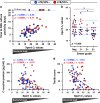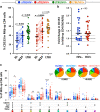Mycobacterium tuberculosis-specific CD4 T cells expressing CD153 inversely associate with bacterial load and disease severity in human tuberculosis
- PMID: 32678272
- PMCID: PMC7855386
- DOI: 10.1038/s41385-020-0322-6
Mycobacterium tuberculosis-specific CD4 T cells expressing CD153 inversely associate with bacterial load and disease severity in human tuberculosis
Abstract
Recent data from mice and non-human primate models of tuberculosis suggested that CD153, a TNF super family member, plays an important role in Mycobacterium tuberculosis (Mtb) control. However, this molecule has not been comprehensively evaluated in humans. Here, we show that the proportion of Mtb-specific CD4 T cells expressing CD153 was significantly reduced in active TB patients compared to latently infected persons. Importantly, the CD153+ Mtb-specific CD4 response inversely correlated with lung bacterial load, inferred by Xpert cycle threshold, irrespective of HIV status. Antitubercular treatment partially restored CD153 expression on Mtb-specific CD4 T cells. This is the first report of a subset of Mtb-specific CD4 T cells showing strong negative correlation with bacterial burden. Building on substantial evidence from animal models implicating CD153 as a mediator of host protection, our findings suggest it may play a similar role in humans and its measurement may be useful to evaluate TB vaccine efficacy.
Conflict of interest statement
The authors declare no competing interests.
Figures






References
-
- WHO (World Health Organization). Global Tuberculosis Report. (WHO, 2019). https://www.who.int/tb/publications/global_report/en/.
-
- Lalvani A, Millington KA. T cells and tuberculosis: beyond interferon-gamma. J. Infect. Dis. 2008;197:941–943. - PubMed
-
- Esmail H, et al. The immune response to Mycobacterium tuberculosis in HIV-1-coinfected persons. Annu Rev. Immunol. 2018;36:603–638. - PubMed
Publication types
MeSH terms
Substances
Grants and funding
LinkOut - more resources
Full Text Sources
Research Materials

